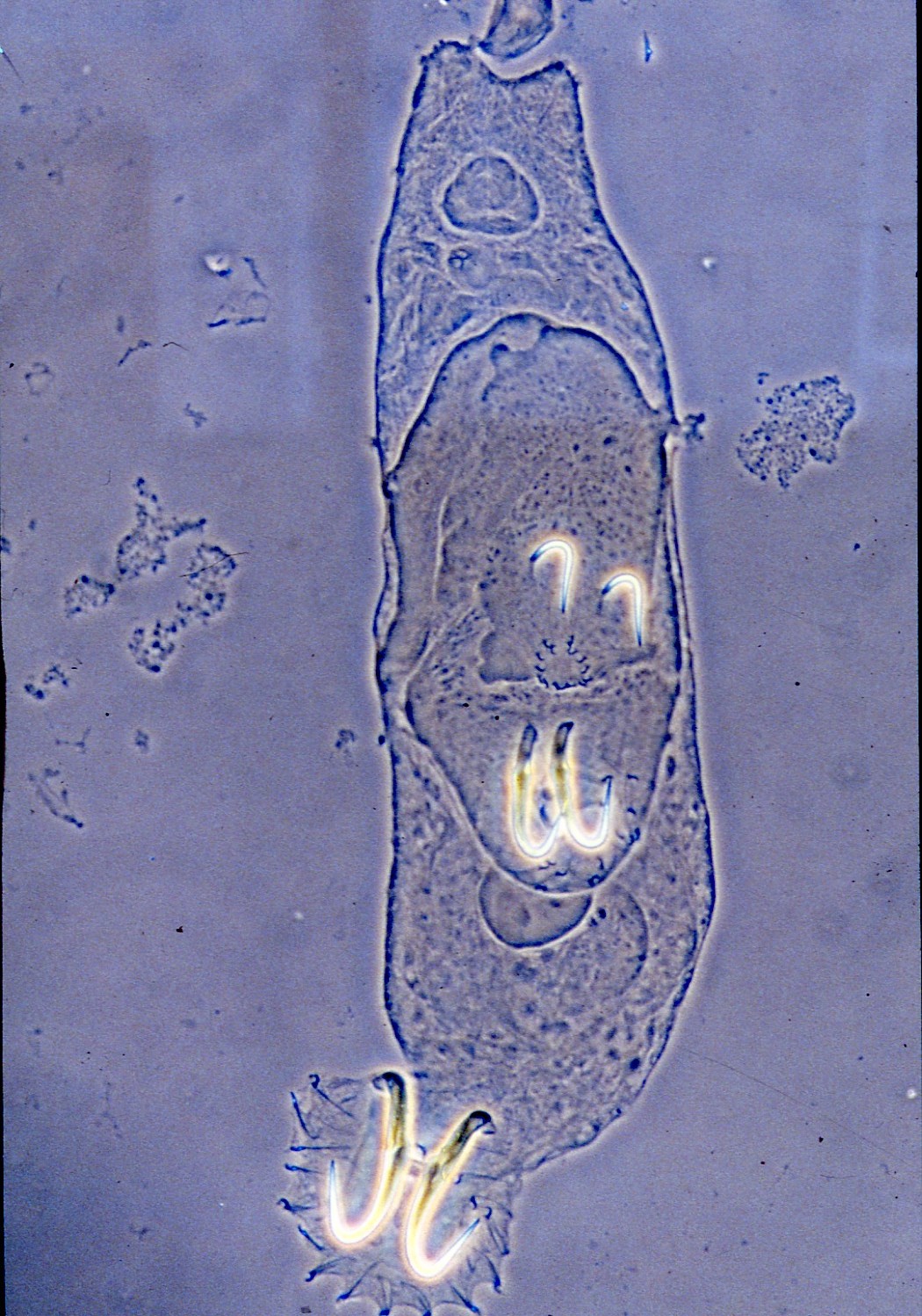

| Parasite | Gyrodactylus spp. |
|---|---|
| Taxonomy | Plathyhelminthes, Monogenea, Monopisthocotylea |
| Hosts | Common carp (Cyprinus carpio), goldfish (Carassius auratus), ayu (Plecoglossus altivelis), rainbow trout (Oncorhynchus mykiss), Atlantic salmon (Salmo salar), Japanese eel (Anguilla japonica), tiger puffer (Takifugu rubripes), etc. |
| Infection site | Skin, fin, gill |
| Clinical signs | Infected fish usually exhibits no external abnormality. Heavily infested fish shows anorexia, lethargy and haemorrhages. |
| Parasitology | Gyrodactylus resembles Dactylogyrus, but the former is viviparous and does not possess eyespots. Gyrodactylus already contains a next generation (F2) in a uterus when born, and within this F2, a third generation (F3) is developing. This resembles the nesting Russian doll. The parasite (< 1mm) attaches to the host by a haptor with 2 pairs of anchors at the posterior end, and feeds on host’s epithelial tissues. Because this parasite is viviparous, the adult transmits directly from fish to fish. G. salaris, a parasite of Atlantic salmon in Europe, is the most famous and pathogenic species among Gyrodactylus. Other well known Gyrodactylus are G. kherulensis and G. sprostonae in common carp, G. kobayashii in goldfish, G. japonicas in ayu, G. masu in rainbow trout, G. rubripedis in tiger puffer, etc. (Ogawa, 2004). |
| Pathology | Parasitized ayu exhibits excessive mucus secretion and petechial haemorrhagic lesions. In case of Atlantic salmon, an epidermal layer becomes thin due to the decrease in density of the mucous cells. |
| Health hazard | Since this parasite is not infectious to human, it is harmless in food hygiene. |
| Diagnosis | Observed the morphology of the parasite in a flattened preparation. It is proposed that morphometric parameters in the marginal hook (Shinn et al., 2000) or rRNA gene (Cunningham et al., 1995) be utilized for the identification for Gyrodactylus. |
| Other information | Mass mortalities of wild Atlantic salmon were recorded in Norwegian rivers in 1970s. A causative agent of the mortalities was demonstrated to be Gyrodactylus salaris which was introduced from foreign countries. In an attempt to prevent spreading of the parasite to neighboring rivers, the fish populations in a Norwegian river were exterminated with a pesticide (Johnson and Jensen, 1991). |
| References | Cunningham, C. O., D.
M. McGillivray, K. Mackenzie and W. T. Melvin (1995): Discrimination between Gyrodactylus salaris, G. derjavini and G. truttae) using restriction fragment length polymorphisms and an
oligonucleotide probe within the small subunit ribosomal RNA gene. Parasitology, 111, 87-94. Johnson, B. O. and A. J. Jensen (1991): The Gyrodactylus story in Norway. Aquaculture, 98, 289-302. Ogawa, K. (2004): Monogenean diseases. Infectious and parasitic diseases of fish and shellfish. (ed. by Wakabayashi, H. and K. Muroga), Koseisha Koseikaku, pp.353-379. Shinn, A. P., J. W. Kay and C. Sommerville (2000): The use of statistical classifiers for the discrimination of species of the genus Gyroductylus (Monogenea) parasitizing salmonids. Parasitology, 120, 261-269. |

Fig. 2. Three pairs of hooks in one individual ofG. kherulensis
were seen.
Fig. 1. NumerousGyrodactylus sp. on the body surface of carp.
(Photos by K. Ogawa)